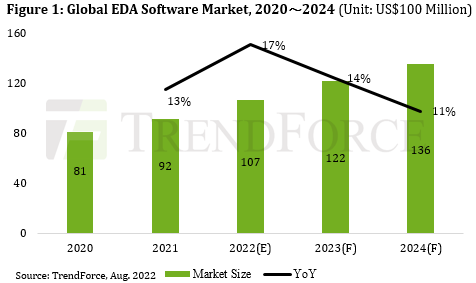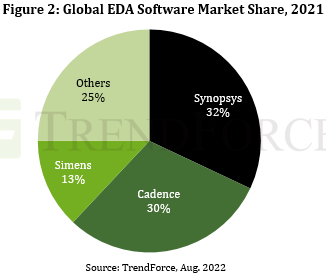New US EDA Software Ban May Affect China's Advanced IC Design, Says TrendForce
August 15, 2022 -- TrendForce provides the following data for the EDA software market:
- Looking at the global EDA software market, market size is estimated to grow from US$8.1 billion to US$13.6 billion from 2020 to 2024, with a compound annual growth rate of 13.8%.
- At present, the EDA software market is oligopolistic, consisting of major players Synopsys, Cadence, and Siemens. According to TrendForce, Synopsys, Cadence, and Siemens account for 32%, 30%, and 13% of the market, respectively, in 2021, for a total 75% market share.
- Before mentioning the recent EDA sanction, recall that the United States placed Huawei on its Entity List in 2019. At that time, American EDA companies including Synopsys and Cadence were affected by the Entity List ban and could not authorize the transfer EDA to Huawei’s HiSilicon. EDA departments and industry revenue as a whole have not experienced a direct impact and the ban has indeed dealt an effective blow to Huawei.
- Empyrean Technology is the leader of China's EDA industry but its technology, revenue scale, and overall influence still fall far behind the American EDA industry. Empyrean Technology's "analog circuit design EDA" and "flat panel display circuit design EDA" are relatively mature while "digital circuit design EDA" and "foundry EDA" still lag significantly behind US-based EDA and have not yet touched upon GAA research and development.
- Even if China purchased a large amount of authorized EDA software before the current sanction takes effect, the software must connect to the developer for license updates before it can be used. This can be effectively controlled by the United States. Although China's IC design has no need for GAA EDA in the short term, it is necessary for developing advanced 3nm process design in 3~5 years. Without US-based EDA tools, Chinese IC design will experience developmental difficulties from initial chip design to back-end system design. Chinese foundries also require the use of EDA and the constraints imposed by US-based equipment and software sanctions may affect the long-term development of China's semiconductor industry.


For more information on reports and market data from TrendForce’s Department of Semiconductor Research, please click here, or email Ms. Latte Chung from the Sales Department at lattechung@trendforce.com
For additional insights from TrendForce analysts on the latest tech industry news, trends, and forecasts, please visit our blog at https://insider.trendforce.com/
Related Semiconductor IP
- Ultra-Low-Power LPDDR3/LPDDR2/DDR3L Combo Subsystem
- Parameterizable compact BCH codec
- 1G BASE-T Ethernet Verification IP
- Network-on-Chip (NoC)
- Microsecond Channel (MSC/MSC-Plus) Controller
Related News
- Siemens to bring advanced timing constraint capabilities to EDA design flow with Excellicon acquisition
- U.S. Restricts EDA Software Sales to China
- U.S. Ban on Huawei Seen Widening China Chip War
- US extends China chip ban
Latest News
- DI3CM-HCI, A High-Performance MIPI I3C Host Controller IP Core for Next-Generation Embedded Designs
- IntoPIX Delivers Real-Time, Low-Power Video Technologies At CES 2026
- Access Advance and Via Licensing Alliance Announce HEVC/VVC Program Acquisition
- Efficient Computer Launches Electron E1 Evaluation Kit to Accelerate Energy-Efficient Computing
- S2C, MachineWare, and Andes Introduce RISC-V Co-Emulation Solution to Accelerate Chip Development